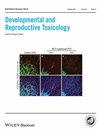母体接触胡椒酰丁醇(PBO)对F1代小鼠生殖和神经行为的影响。
Q Environmental Science
Birth defects research. Part B, Developmental and reproductive toxicology
Pub Date : 2016-08-01
DOI:10.1002/bdrb.21185
引用次数: 4
摘要
在妊娠期和哺乳期,雌性小鼠通过饲粮暴露于0(对照)、0.015、0.03和0.06%水平的胡椒酰丁醇(PBO),并在F1代测量所选择的生殖和神经行为参数。PBO对产仔数、产仔重或出生性别比没有不良影响。除PND 21低剂量组雌鼠外,哺乳期雌鼠的平均体重均未受PBO治疗的显著影响。在行为发育参数方面,低剂量组雌性后代在PND 7上的游动方向明显加快(p = 0.022)。雄性子代探索性行为检查显示,总距离和运动时间均以剂量相关方式显著缩短(p = 0.0138和0.00231),平均饲养时间以剂量相关方式显著延长(p = 0.00814),排尿次数以剂量相关方式显著增加(p < 0.05)。对于自发行为检查,雄性的平均运动时间和雌性的平均饲养时间在F1代中表现出轻微的剂量相关效应。本研究中PBO的剂量水平对小鼠的神经行为参数产生了一些不良影响。本文章由计算机程序翻译,如有差异,请以英文原文为准。
Reproductive and neurobehavioral effects of maternal exposure to piperonyl butoxide (PBO) in F1 -generation mice.
Female mice were exposed maternally to piperonyl butoxide (PBO) through diet to provide levels of 0 (control), 0.015, 0.03, and 0.06% during gestation and lactation periods, and selected reproductive and neurobehavioral parameters were measured in F1 generation. There was no adverse effect of PBO on litter size, litter weight, or sex ratio at birth. The average body weights of offspring showed no significant effects of PBO treatment through the lactation period in both sexes except for the low-dose group of females on PND 21. With respect to behavioral developmental parameters, swimming direction of female offspring on PND 7 was significantly accelerated in the low-dose group (p = 0.022). Exploratory behavior examination in male offspring indicated that total distance and movement time shortened significantly in dose-related manners (p = 0.0138 and 0.00231, respectively), average time of rearing lengthened significantly in a dose-related manner (p = 0.00814), and the frequencies of mice with urination was increased significantly in a dose-related manner (p < 0.05). For spontaneous behavior examination, the average time of movement in males and average time of rearing in females showed slightly dose-related effects in the F1 generation. The dose levels of PBO in the present study produced some adverse effects in neurobehavioral parameters in mice.
求助全文
通过发布文献求助,成功后即可免费获取论文全文。
去求助
来源期刊
CiteScore
1.65
自引率
0.00%
发文量
0
审稿时长
>12 weeks
期刊介绍:
The purpose of this journal is to publish original contributions describing the toxicity of chemicals to developing organisms and the process of reproduction. The scope of the journal will inlcude: • toxicity of new chemical entities and biotechnology derived products to developing organismal systems; • toxicity of these and other xenobiotic agents to reproductive function; • multi-generation studies; • endocrine-mediated toxicity, particularly for endpoints that are relevant to development and reproduction; • novel protocols for evaluating developmental and reproductive toxicity; Part B: Developmental and Reproductive Toxicology , formerly published as Teratogenesis, Carcinogenesis and Mutagenesis

 求助内容:
求助内容: 应助结果提醒方式:
应助结果提醒方式:


